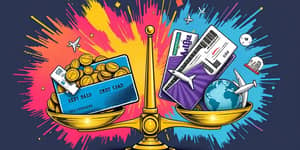Credit card debt is weighing heavily on millions of Americans today, creating stress and uncertainty. In 2025, record balances and high interest rates are pushing families to the brink, but there is hope. This article offers a detailed roadmap, expert-backed methods, and emotional support to help you take control of your finances and reclaim peace of mind.
The Scope of Credit Card Debt in 2025
Credit card debt in May 2025 hit an all-time high, with many consumers maxing out cards and making only minimum payments. Average unpaid balances climbed to 7321 dollars per cardholder in the first quarter of 2025, up 5.8 percent from the previous year. High APRs near 29.99 percent mean balances can swell rapidly if left unchecked.
Long-term indebtedness is also on the rise. Over half of indebted cardholders have carried debt for more than a year, and nearly half of all users roll balances from month to month. Credit ownership remains widespread, with three out of four adults holding at least one personal card, spanning every generation from Gen Z to baby boomers.
Delinquency and Demographic Shifts
While delinquency rates have eased slightly after recent spikes, 3.05 percent of balances are at least 30 days late. Lower-income households have borne the brunt of this increase, seeing a 63 percent rise in late payments since 2021 compared to 44 percent among higher-income groups.
Driving Forces: Why Debt Is Surging
Several factors are converging to drive this surge in credit card debt. Persistent high inflation and elevated interest rates have eroded purchasing power, forcing many families to lean on plastic for everyday expenses. Wages have failed to keep pace with rising costs, creating a structural gap that credit temporarily fills.
Emergency savings are insufficient for most households, leaving families vulnerable to unplanned medical bills, car repairs, or sudden job disruptions. As a result, credit cards have become a stopgap for inflation-driven cost increases and unexpected shocks, trapping many in a cycle of revolving balances and mounting interest charges.
Expert-Backed Repayment Strategies
Breaking free from credit card debt requires a structured approach. Experts recommend several proven methods tailored to different personalities, financial situations, and goals. Review each option carefully and choose the path that aligns with your needs and motivation style.
- Snowball Method: Focus on paying off your smallest balance first to gain quick wins. Make minimum payments on other cards, then roll the freed-up amount into the next smallest debt for momentum and confidence.
- Avalanche Method: Target the card with the highest interest rate while maintaining minimum payments elsewhere. Once the most expensive debt is eliminated, apply that payment to the next highest-rate balance to minimize total interest paid.
- Balance Transfer Cards: Transfer high-interest balances to a card offering 0 percent introductory APR for 12 to 21 months. This produces an interest holiday—though fees and expiration dates require careful planning to avoid penalties.
- Debt Consolidation Loans: Combine multiple card balances into a single personal loan with a potentially lower fixed rate. This simplifies monthly bills and can save money on interest, provided the new rate is favorable and fees are minimal.
Customizing Your Plan and Maintaining Momentum
Your ideal strategy depends on your debt size, budget, and personal drive. The snowball method appeals to those needing psychological boosts with quick results, while the avalanche method suits disciplined savers focused on long-term gain. Consolidation offers simplicity for busy households, and balance transfers provide short-term relief when executed correctly.
Whatever path you choose, create a realistic budget that prioritizes debt reduction. Track spending, cut nonessential costs, and redirect savings toward your repayment plan. Celebrate every milestone—whether it’s paying off a single card or reducing total balances by 10 percent—to reinforce positive habits and sustain your commitment.
Social and Emotional Well-Being
Financial stress can strain relationships, erode self-esteem, and contribute to anxiety. Acknowledging the emotional toll of debt is crucial. Seek support from trusted friends or financial mentors, and consider professional counseling if anxiety feels overwhelming.
Share your goals with loved ones to build accountability. A supportive network can offer encouragement during challenging moments and celebrate breakthroughs, turning what feels like a solitary struggle into a collective journey toward freedom.
Cautions and Best Practices
Avoid falling into common traps. Paying only the minimum extends repayment time and amplifies interest costs, keeping you in debt longer. Always read the fine print on promotional offers—hidden fees or expiration clauses can turn a solution into a setback.
Maintain an emergency fund even as you pay down debt. A small cushion, such as a few hundred dollars, can prevent future reliance on high-interest credit during unexpected events. Staying disciplined today fosters resilience and financial stability tomorrow.
Taking control of credit card debt is a journey of discipline, education, and perseverance. By understanding the forces at play, selecting a tailored strategy, and nurturing emotional resilience, you can outpace mounting interest, eliminate balances, and build a secure financial future. Start your repayment plan today and embrace the relief that comes with regained freedom.
References
- https://www.youtube.com/watch?v=yrksgzdrjQE
- https://www.pnc.com/insights/personal-finance/spend/how-to-pay-off-credit-card-debt.html
- https://www.lendingtree.com/credit-cards/study/credit-card-debt-statistics/
- https://www.experian.com/blogs/ask-experian/credit-education/how-to-pay-off-credit-card-debt/
- https://www.bankrate.com/credit-cards/news/credit-card-debt-report/
- https://www.equifax.com/personal/education/debt-management/articles/-/learn/paying-off-debt-strategies/
- https://www.stlouisfed.org/on-the-economy/2025/may/broad-continuing-rise-delinquent-us-credit-card-debt-revisited
- https://www.bairdwealth.com/insights/wealth-management-perspectives/2022/08/5-strategies-for-paying-off-credit-card-debt/










